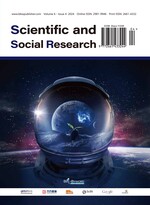Spatiotemporal Coupling between Urbanization and Eco-environment based on Google Earth Engine and Nighttime Light Data: A Case Study of the Yellow River Delta
Abstract
Based on the cloud platform of Google Earth Engine and ArcGIS, this paper uses daytime optical remote sensing and nighttime light (NTL) remote sensing data to extract the comprehensive nighttime light index (CNLI) and remote sensing ecological index (RSEI) respectively, then constructed and quantitatively analyzed the coupling coordination distance model of urbanization and eco-environmental quality in the study area from 2001 to 2020. The results show that the average value of RSEI fluctuated from 0.446 in 2001 to 0.518 in 2020 from 2001 to 2020. The average value of CNLI from 2001 to 2020 continued to rise from 0.101 in 2001 to 0.238 in 2020. From 2001 to 2020, the average value of the coupling coordination degree showed a downward trend, from 1.356 in 2001 to 1.256 in 2020, and the coupling coordination degree gradually developed in a good direction. The research results can provide data support and theoretical suggestions for promoting the sustainable development of the Yellow River Delta.
References
Wu JG, 2013, Landscape Sustainability Science: Ecosystem Services and Human Well-Being in Changing Landscapes. Landscape Ecology, 28(6): 999–1023.
Liu X, Huang Y, Xu X, et al., 2020, High-spatiotemporal-resolution mapping of Global Urban Change from 1985 to 2015. Nature Sustainability, 3(7): 1–7.
United Nations, 2015, Transforming Our World: The 2030 Agenda for Sustainable Development. https://sdgs.un.org/2030agenda
Filho WL, Salvia AL, Eustachio JHPP, 2022, An Overview of the Engagement of Higher Education Institutions in the Implementation of the UN Sustainable Development Goals. Journal of Cleaner Production, 386(16): 135694.
Li WJ, An M, Wu HL, et al., 2022. The Local Coupling and Telecoupling of Urbanization and Ecological Environment Quality Based on Multisource Remote Sensing Data. Journal of Environmental Management, 2022(327): 116921.
Howard E, 2007, Garden Cities of To-morrow. Organization & Environment, 16(1): 98–107.
Caviglia-Harris JL, Chambers D, Kahn JR, 2009, Taking the “U” out of Kuznets: A Comprehensive Analysis of the EKC and Environmental Degradation. Ecological Economics, 68(4): 1149–1159.
Berger AR, Hodge RA, 1998, Natural Change in the Environment: A Challenge to the Pressure-State-Response Concept. Social Indicators Research, 44(2): 255–265.
Lewison RL, Rudd MA, AI-Hayek W, et al., 2016, How the DPSIR framework can be used for Structuring Problems and Facilitating Empirical Research in Coastal Systems. Environmental Science & Policy, 2016(56): 110–119.
Buyantuyev A, Wu JG, Gries C, 2009, Multiscale Analysis of the Urbanization Pattern of the Phoenix Metropolitan Landscape of USA: Time, Space and Thematic Resolution. Landscape and Urban Planning, 94(3): 206–217.
Checon HH, Corte GN, Esmaeili YS, et al., 2023, The Efficacy of Benthic Indices to Evaluate the Ecological Quality and Urbanization Effects on Sandy Beach Ecosystems. Science of The Total Environment, 856(2): 159190.
Ding TH, Chen JF, Fang Z, et al., 2021, Assessment of Coordinative Relationship between Comprehensive Ecosystem Service and Urbanization: A Case Study of Yangtze River Delta Urban Agglomerations, China. Ecological Indicators, 2021(133): 108454.
Wang ZB, Liang LW, Sun Z, 2019, Spatiotemporal Differentiation and the Factors Influencing Urbanization and Ecological Environment Synergistic Effects within the Beijing-Tianjin-Hebei Urban Agglomeration. Journal of Environmental Management, 243(1): 227–239.
He JQ, Wang SJ, Liu YY, et al., 2017, Examining the Relationship between Urbanization and the Eco-Environment using a Coupling Analysis: Case study of Shanghai, China. Ecological Indicators, 2017(77): 185–193.
Zou C, Zhu JW, Lou KL, et al., 2022, Coupling Coordination and Spatiotemporal Heterogeneity between Urbanization and Ecological Environment in Shaanxi Province, China. Ecological Indicators, 141(2): 109152.
Xiong Y, Xu WH, Lu N, et al., 2021, Assessment of Spatial-temporal Changes of Ecological Environment Quality based on RSEI and GEE: A Case Study in Erhai Lake Basin, Yunnan Province, China. Ecological Indicators, 2021(125): 107518.
Cai J, Li XP, Liu LJ, et al., 2021, Coupling and Coordinated Development of New Urbanization and Agro-ecological Environment in China. Science of The Total Environment, 2021(776): 145837.
Shi KF, Huang C, Yu BL, et al., 2014, Evaluation of NPP-VIIRS Night-time Light Composite Data for Extracting Built-up Urban Areas. Remote Sensing Letters, 5(4–6): 358–366.
Jing YQ, Zhang F, He YF, et al., 2020, Assessment of Spatial and Temporal Variation of Ecological Environment Quality in Ebinur Lake Wetland National Nature Reserve, Xinjiang, China. Ecological Indicators, 2020(110): 105874.
Zheng ZH, Wu ZF, Chen YB, et al., 2021, Analyzing the Ecological Environment and Urbanization Characteristics of the Yangtze River Delta Urban Agglomeration based on Google Earth Engine. Acta Ecologica Sinica, 41(2): 717–729.
Jiang L, Bai L, Wu YM, 2017, Coupling and Coordinating Degrees of Provincial Economy, Resources and Environment in China. Journal of Natural Resources, 32(05): 788–799.
Hong WY, Yang CY, Chen LX, et al., 2017, Ecological Control Line: A Decade of Exploration and an Innovative Path of Ecological Land Management for Megacities in China. Journal of Environmental Management, 2017(191): 116–125.
Feng YX, He SW, Li GD, 2021, Interaction between Urbanization and the Eco-environment in the Pan-Third Pole Region. Science of The Total Environment, 2021(789): 148011.

